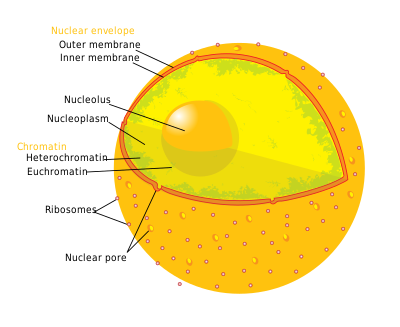Nuclear envelope
| Nuclear membrane | |
|---|---|

Human cell nucleus
|
|
| Identifiers | |
| TH | H1.00.01.2.01001 |
| FMA | 63888 |
|
Anatomical terminology
[]
|
|
A nuclear membrane, also known as the nucleolemma or karyotheca, is the phospho lipid bilayer membrane which surrounds the genetic material and nucleolus in eukaryotic cells.
The nuclear membrane consists of two lipid bilayers—the inner nuclear membrane, and the outer nuclear membrane. The space between the membranes is called the perinuclear space, a region contiguous with the lumen (inside) of the endoplasmic reticulum. It is usually about 20–40 nm wide. The nuclear membrane also has many small holes called nuclear pores that allow material to move in and out of the nucleus.
The outer nuclear membrane also shares a common border with the endoplasmic reticulum. While it is physically linked, the outer nuclear membrane contains proteins found in far higher concentrations than the endoplasmic reticulum. All 4 Nesprin proteins present in mammals are expressed in the outer nuclear membrane. Nesprin proteins connect cytoskeletal filaments to the nucleoskeleton. Nesprin-mediated connections to the cytoskeleton contribute to nuclear positioning and to the cell’s mechanosensory function. KASH-domain proteins of Nesprin-1 and -2 are part of a LINC complex (Linker of Nucleoskeleton and Cytoskeleton) and can bind directly to cystoskeletal components, such as actin filaments, or can bind to proteins in the luminal domain of the nuclear membrane. Nesprin-3 and-4 may play a role in unloading enormous cargo; Nesprin-3 proteins bind plectin and link the nuclear envelope to cytoplasmic intermediate filaments. Nesprin-4 proteins bind the plus end directed motor kinesin-1. The outer nuclear membrane is also involved in development, as it fuses with the inner nuclear membrane to form nuclear pores.
The inner nuclear membrane encloses the nucleoplasm, and is covered by the nuclear lamina, a mesh of intermediate filaments which stabilizes the nuclear membrane as well as being involved in chromatin function and entire expression. It is connected to the outer membrane by nuclear pores which penetrate the membranes. While the two membranes and the endoplasmic reticulum are linked, proteins embedded in the membranes tend to stay put rather than dispersing across the continuum.
...
Wikipedia
